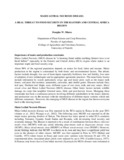| dc.description.abstract | Maize Lethal Necrosis (MLN) disease is “a looming threat unlike anything farmers have ever
faced before”i especially in the Eastern and Central Africa (ECA) region where maize is an
important staple and food security crop.
About 90% of the regional population depends on maize for food, labor and income. Maize
production in the region is constrained by both biotic and environmental factors. The abiotic
factors include drought, low use of farm inputs especially fertilizers, low soil fertility, low rates
of adoption of new technologies and in-appropriate agronomic practices. The main biotic factors
include infestation by weeds particularly striga spp and insect pests such as the maize stalk
borers, soil pests like termites, nematodes, cutworms, and chaffer grubs. Diseases include Grey
leaf spot, Northern leaf blight, rusts, different types of rots (root, stalk and ear), smuts, Maize
streak virus and Maize Lethal Necrosis (MLN) disease. Other biotic factors include wildlife
damage on crops that neighbor forested areas, birds and post-harvest losses. Managing these
constraints has been a continuous process involving different stakeholders in the maize industry
and production was on the increase with the introduction of different maize varieties which met
different consumers. However, the emerging of MLN disease in the region has thrown everyone
back to the drawing board. | en_US |

